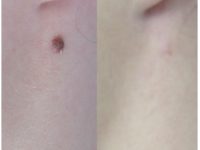
What Are Skin Tags?
April 4, 2019
Why Glitter Should be Banned in Makeup!
May 9, 2019
[av_textblock size=” av-medium-font-size=” av-small-font-size=” av-mini-font-size=” font_color=” color=” id=” custom_class=” template_class=” av_uid=’av-l2fkcj2r’ sc_version=’1.0′ admin_preview_bg=”] Associated Ricks While typically harmless, current research suggests that there is a strong association between skin tags and prediabetes, also called insulin resistance, and Type-2 diabetes. In those with insulin resistance, insulin becomes ineffective at pushing sugar into cells and, as such, the blood sugar builds up and the body keeps producing more insulin in an attempt to normalize blood sugar. Eventually, the pancreas becomes exhausted and diabetes results. Early detection can prevent the development of this deadly disease. Diabetics, on average, live 10 to 15 years less than non-diabetics. Dozens of studies show that as few as three skin tags on the body are linked to increased diabetes risk. Research has also shown that those with skin tags have higher cholesterol, triglycerides, blood sugar, and C-reactive protein (CRP) than those without skin tags (all risk factors for diabetes and cardiovascular disease). Those with elevated CRP, a marker for inflammation in the body, are four times more likely to develop diabetes. Thus, while many are bothered by the appearance of their skin tags, they can be a useful warning sign for diabetes that should not be ignored. Recent studies have also linked a higher incidence of skin tags to conditions such as obesity and metabolic syndrome, high levels of cholesterol, and human papilloma virus. Studies of biopsied skin tags have found that some low-risk forms of the human papilloma virus (HPV) are often present in the tissue. However, the tags themselves are harmless (and not contagious), and they don’t need to be treated. How Do I Get Rid of a Skin Tag? Just because skin tags are common doesn’t mean they aren’t bothersome. If your skin tags irk you, rub against clothing, get caught in jewelry, itch, or you just don’t like the way they look, you may want to consider having them removed. There are a few different options available. However, before doing so most dermatologists recommend getting your skin tags checked out by a professional. dermatologists recommend getting your skin tags checked out by a professional. It is possible to misdiagnose them, and you don’t want to ignore a more serious medical issue. However, skin tags can be removed by sealing off the blood supply, quickly and efficiently by: Electrocautery is a procedure that uses light electrical current to burn the skin tags or mole off, reaching only the outermost layers of the skin (so scarring is not a problem). Approximately 1-2 treatments may be needed. Local anesthetic is applied to the treated area before the procedure. Compared to cyrotherapy skin tag or mole removal, removing skin tag with electrocautery is easier to perform and control, so it can be safer, and more efficient. Cyrotherapy is a treatment that removes skin tag or mole by freezing them using liquid nitrogen. The results of these skin tag or mole removal procedures depend greatly on the performer’s skill and expertise. skin burning or scaring could result from the treatment. Laser or IPL is usually used for removing flat and pigmented skin tags or moles. This method of skin tag or mole removal may require about 3 treatments to make the flat skin tag or mole invisible. The laser beam or pulsed light is selectively absorbed by the pigment of the skin tag or mole, which is then destroyed and shed away. Excision is a surgical solution for skin tags and moles, usually used to remove skin tags or moles that are potentially cancerous. The doctor may numb the treated area with local anesthesia and then remove the mole with a medical blade or incision. In the case of atypical moles, the doctor may remove a margin of surrounding skin as well. Since excision treatment usually leaves some degree of scarring, many patients have had disappointing experience with excision mole removal. Since skin tags aren’t harmful to your health, health insurance plans typically don’t cover removal service. It’s considered a cosmetic procedure, unless the skin tag is particularly irritating or prone to bleeding. This, removal can cost hundreds of dollars out of pocket. Therefore, it’s no surprise that people would rather remove their skin tags without visiting a professional facility. Many dermatologists strongly recommend having a licensed professional remove your skin tags rather than trying to excise them at home, cautioning that improper removal can result in infection and scarring.
Please call us for a complementary consultation at 416-228-0011
Facial Laser Hair Removal Toronto
Skincare Clinic North York
Laser Hair Removal North York
Sun Spots Removal Toronto
Dark Spots Removal Toronto
Facial Skin Treatments Toronto
Facial Skin Treatments Toronto
micro-needling toronto
Chemical Peel Toronto
CoolSculpting fat reduction Toronto
Laser Spider Veins Removal Toronto
Facial laser hair removal Toronto
[/av_textblock]




